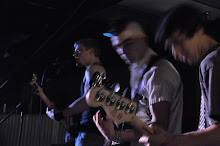As I have stated in my previous entry, I am not the biggest fan of this movie or how it tried to get it's message across, however, the way the scenes and props were used was unquestionably excellent. Throughout the film there are many different locations presented along with specific characters that inhabit them. For example, the pizzeria contained Sal and his sons working, the food market always had the Korean grocer usually in some kind of conflict with the locals, and the blank red wall on the street had the three men relaxing the day away. There are many more examples but these are just a few that stuck out to me. All of these scenes are intertwined with one another throughout the movie as characters shift from location to location showing how the town was a community and a family of sorts. Radio Raheem's boombox is one clear piece of mise-en-scene. This loud, thunderous noisemaker is constantly playing public enemy's "fight the power" which is an underlying motif of the whole film. The boombox represents the overall feel of the neighborhood towards the system or "the man." Another aspect of Radio's apparel that stands out as a representation of the citizens of Brooklyn are his love and hate brass knuckles. These accessories showed me that Radio believes in love over hate, but that to accomplish love one might have to use hate.
This brings me to the scene where Mookie runs into Radio on the street. Mookie is supposed to be delivering a pizza but stops, as usual, to make conversation with Radio. It is at this point where Radio shows off his brass knuckles and explains the constant struggle of the two words with love eventually triumphing. The way this scene is shot is very unique and captivating. As it starts, you see both Radio and Mookie from the side, but as Radio begins to give his explanation, the camera pans directly in front of Radio cutting out Mookie making the viewer feel as if they are in Mookie's shoes watching Radio face to face. Once Radio is finished, the camera pans back out to the side and both actors are seen again. This scene gave me a better feel for Radio's character rather than just the mute giant wandering around in previous scenes. It also shows how Mookie is a common friend among almost everyone and is able to fit in with everyone he meets.
Before I begin rambling on about cinematography, let me get back to mise-en-scene. One reoccurring piece of mise-en-scene that stuck out to me was the sidewalk chalk that Mookie constantly walked across on his trips to and from the pizzeria. This sidewalk art depicts smiling faces and sunshine. A little child is always sitting on the ground drawing away. This shows that even in a town where racial conflict and tension is prevalent, the innocence of children is still present. This innocence, however, can be easily corrupted by the constant racial bickering and can cause a child's mind to stop focusing on the good and simple things in life.
There are so many excellent aspects of mise-en-scene in this movie that I could go on a rant forever but I will focus my thoughts on one final scene. The scene at the end when all hell breaks loose on the pizzeria. This scene attempts to convey the main message of the movie. Throughout the film, local patrons come in and out of Sal's pizzeria and have several moments of conflict with the staff. These moments of conflict are seen to the locals as normal discussion and their idea of anti-violence. When these conflicts prove fruitless, the people, sparked by the death of Radio Raheem, resort to violence as a means of self-defense from prejudice and hate. The pizzeria is seen throughout the movie as a source of this prejudice. When Mookie breaks the window with a trash can, he breaks the barrier of hate towards the community. One funny aspect, is that the main conflict was about the pictures hanging in the pizzeria and at the end Smiley stumbles through the smoldering ashes and embers of the pizzeria just to hang a photo of Martin Luther King Jr. and Malcolm X shaking hands. This shows the idea that either with non-violence or, if necessary, violence the people's goal will be accomplished. All of the racial conflict could be easily avoided if everyone simply accepted people for who they were. However, standing for what you believe in is doing the right thing and that is what Mookie did by starting the riot against Sal's pizzeria.





